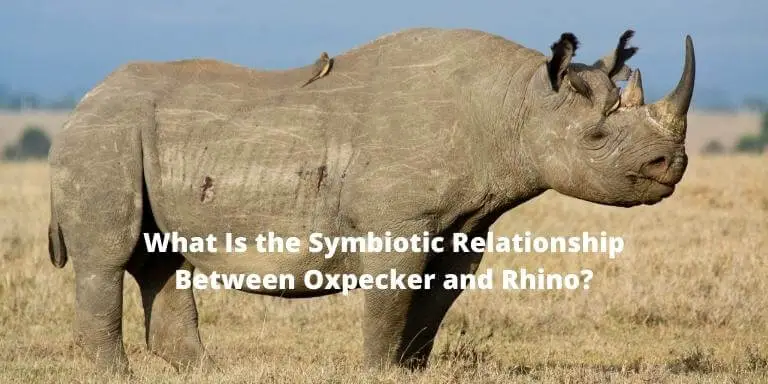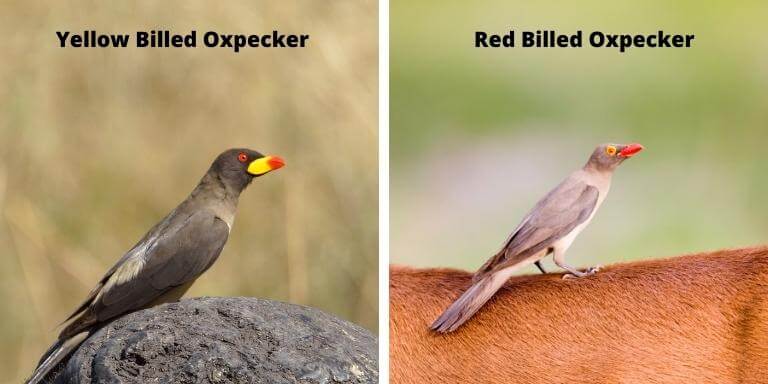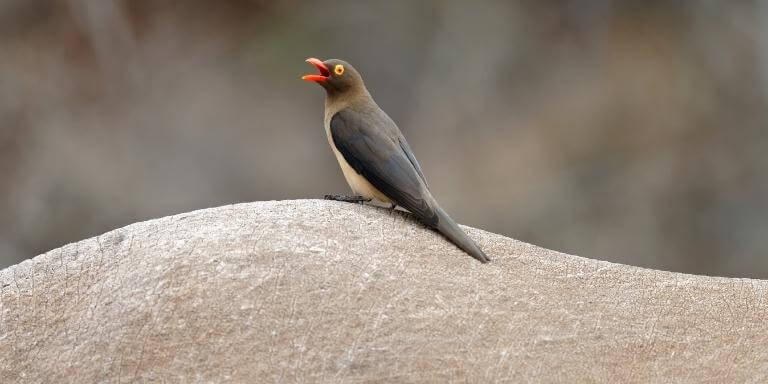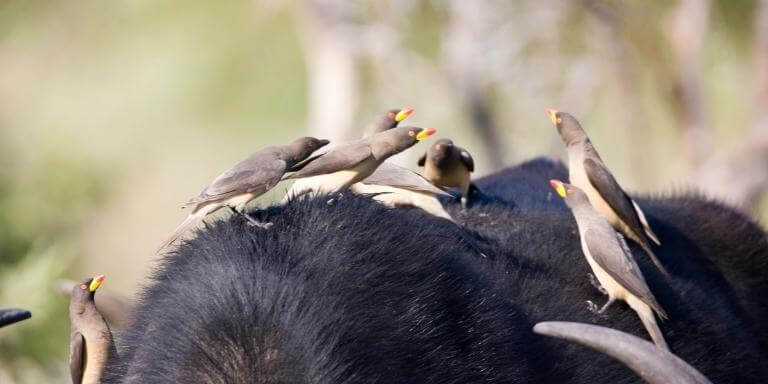Oxpeckers and Rhinos share a very unique and mutualistic relationship between them. In this process, the yellow-billed bird called oxpecker eats ticks, flies, maggots, and other bot-fly larvae from the rhinoceros’ back. Rhinos get pest control. They both are well-known throughout the savannas region of Sub-Saharan Africa.

What Is the Symbiotic Relationship Between Oxpecker and Rhino?
Any Interaction between two biological species is known as a symbiotic relationship. Sometimes it may be confused by this type of relationship between Oxpeckers and Rhinos. Is it a mutualism or commensalism relationship? Let’s find out.
Commensalism: Commensalism refers to a long-term relationship between two living species in which one gets benefits from the other without damaging it. But a recent analysis found that at some point oxpeckers can be harmful to their hosts. they make wounds and more often they deteriorate the injuries in order to feed blood through that spot. So we can say that it isn’t an ideal example of commensalism.
Mutualism: It’s a mutually beneficial partnership in which both species benefit each other. The yellow-billed bird gets adequate amounts of food such as ticks, flies, dead skin while the rhinoceros gets pest and diseases controlled at the same time. Oxpeckers eat pretty nearly everything they can find on the backs of the mammal.
However, This partnership can be a little complicated sometimes. For instance, if one species benefits more from the other one, the interaction could be considered parasitic. The oxpecker can be seen as both a parasite and a helper to its greater hosts. Despite all of the complexity, you can call it a mutualism relation.
Interaction Between Oxpeckers and Rhinos

There are two types of oxpeckers are found. One is the red-billed oxpecker (Buphagus erythrorhynchus) and the other one is called as yellow-billed oxpecker (Buphagus africanus).
Both of them spend a lot of time hanging to huge grazing herbivores like wildebeest, rhinoceros, or zebras. Rhinoceros without oxpeckers can hardly spot human stalkers, It is almost one-fourth of the time, They can’t see far from the proximity of around 23 meters (about 75 feet). The animal can spot a human intruder 100 percent of the time with an oxpecker guard at a far longer range of 61 meters (200 feet).
How do oxpeckers help rhinos?

Oxpeckers are also known as “ASKARI WA KIFARI” means “Rhino’s Guard”. Oxpeckers comfortably live on the rhino’s body and eat ticks and other flies. They take care of rhinos in the following way:
- They help to keep the mammal’s parasite under control while also providing an easy meal for the birds.
- The Oxpeckers remove earwax from rhino.
- The Oxpeckers also benefit their mammalian hosts by providing them with an early warning system when they see the danger and make a hissing noise whenever they got frightened.
The birds provided a significant advantage in terms of avoiding potential hunters. Oxpeckers dig on their hosts to remove hair and fur in addition to food. The silky fuzz is used to line their nests. some folks may even pick the wool of animals to get the nice material for their nest.

Do oxpeckers harm rhinos?
Oxpecker birds can be harmful to their hosts as they can cause injuries to their bodies. When these birds bother the host too much, rhinos immediately attempt to shake them off from their back by swishing their tails or sometimes by shaking their legs. It is not completely advantageous to them.
The birds prefer to stick to hosts with a lot of them, eat parasites and dig into wounds. Sometimes the mammals seem relatively tolerant of this kind of behavior.
Do Oxpeckers Drink Blood?

These Galápagos Mockingbirds consume the blood of the injured animal. they’re also known to peck at wounds and feed tissue. Another interesting piece of info you should know is that people started to call them vampires after watching them suck the victim’s blood.
Typically oxpeckers are also known as tick birds. Their name comes from their habit of looking at ticks from rhinos or other large herbivores like buffalo, antelope, lions, and zebra.
Relationship Between Rhino and Other Birds

An egret is a little white bird found in Africa. Habitats in both conditions; fresh or saltwater. They feed small fishes, amphibians, reptiles, mice, and other creatures that live near water.
Rhino and egret, both share a mutualistic relationship where the Rhino gets cleaned and the egret is fed. Egret is very important to the rhino. The egret also informs the rhino when it feels an enemy approaches. Since both organisms benefitted equally from one other this egret-large mammal’s relationship may be called another example of mutualism.
There are many other birds that try to nest on the backs of rhinoceros. Some chattering social birds are frequently seen on rhinos’ backs and munching on parasitic ticks.
Oxpeckers and Grazing Animals

In Zimbabwe, an experiment was conducted in 1999 and the researchers found that cattle without the oxpeckers had more ticks than those who had the birds. The oxpeckers seem very targeted towards insects of the mammal body.
Due to the abundance of insects, oxpeckers avoid smaller animals such as duikers and reedbucks. Cause a smaller body means less food for survivors.
Conclusion
All types of relationships are vital for ensuring natural balances. Animals have evolved themselves in a variety of lifestyles or processes according to environmental needs. Despite being a gigantic creature Rhino possesses a very distinctive mutualistic relationship with little Oxpecker birds.
You might also be interested in:
- How Fast Can a Rhino Run? All 5 Species Speed Comparison
- Can Rhinos Jump or Walk Backwards?
- Do Rhinos Lay Eggs? Rhino Reproduction Explained
- Can Rhinos Swim? You Will Be Surprised!
- How Many Toes Does a Rhino Have on Each Foot?
- What Sound Does a Rhino Make? Sound Effects Included
- How Strong is a Rhino? Disastrous Videos Included
- Are Rhinos Intelligent? How to Train a Rhino?
- How Much Does a Rhinoceros Cost
- Why Do Rhinos Put Out Fires? Is It a Myth or Reality?
